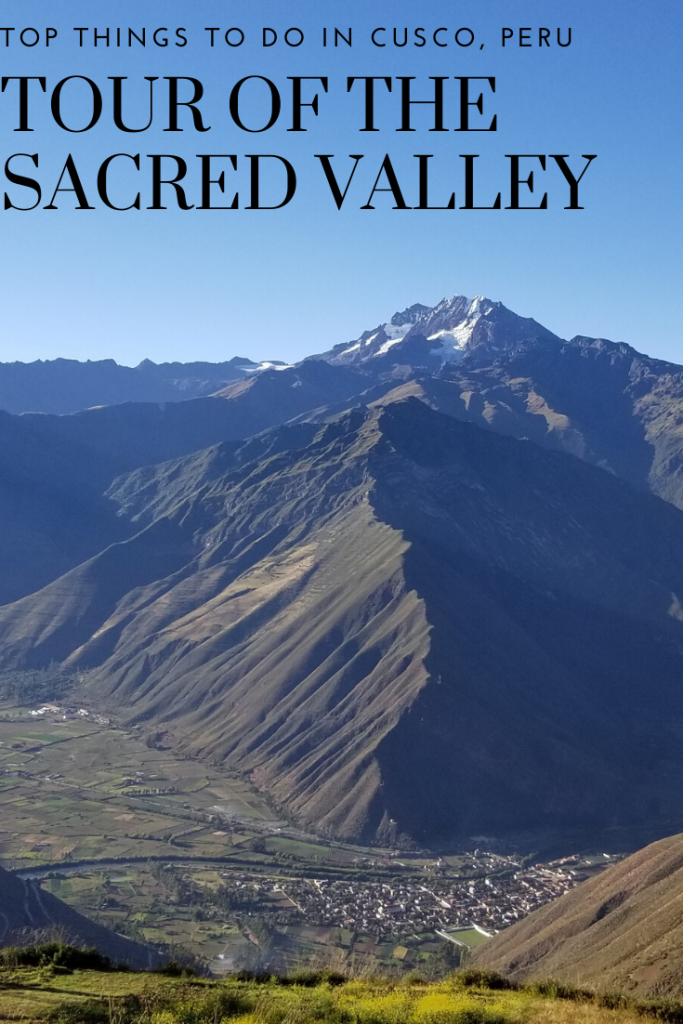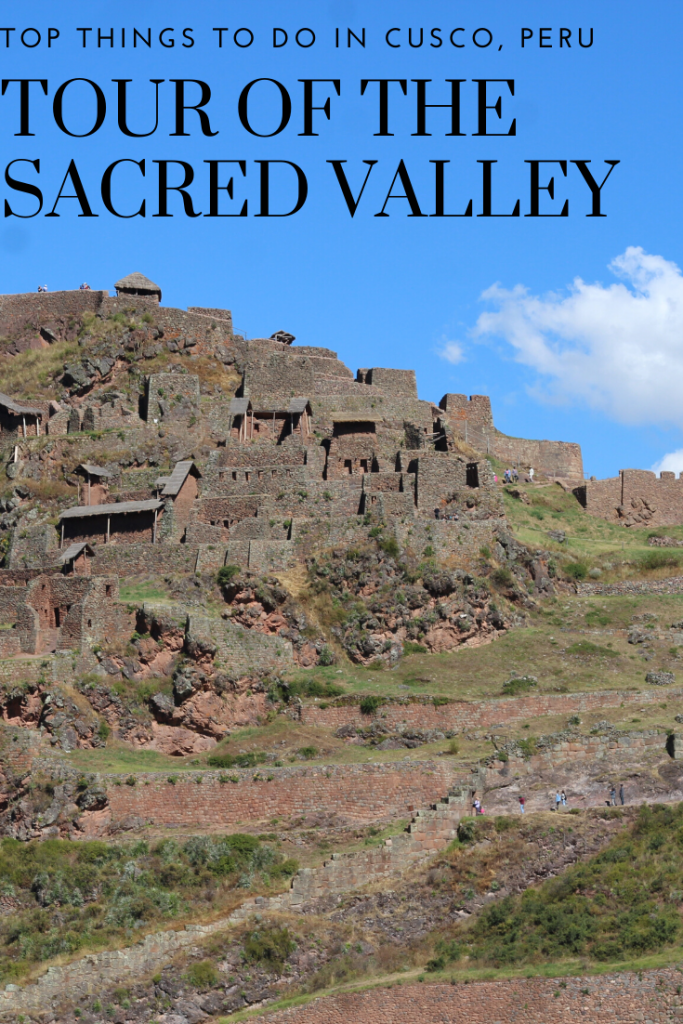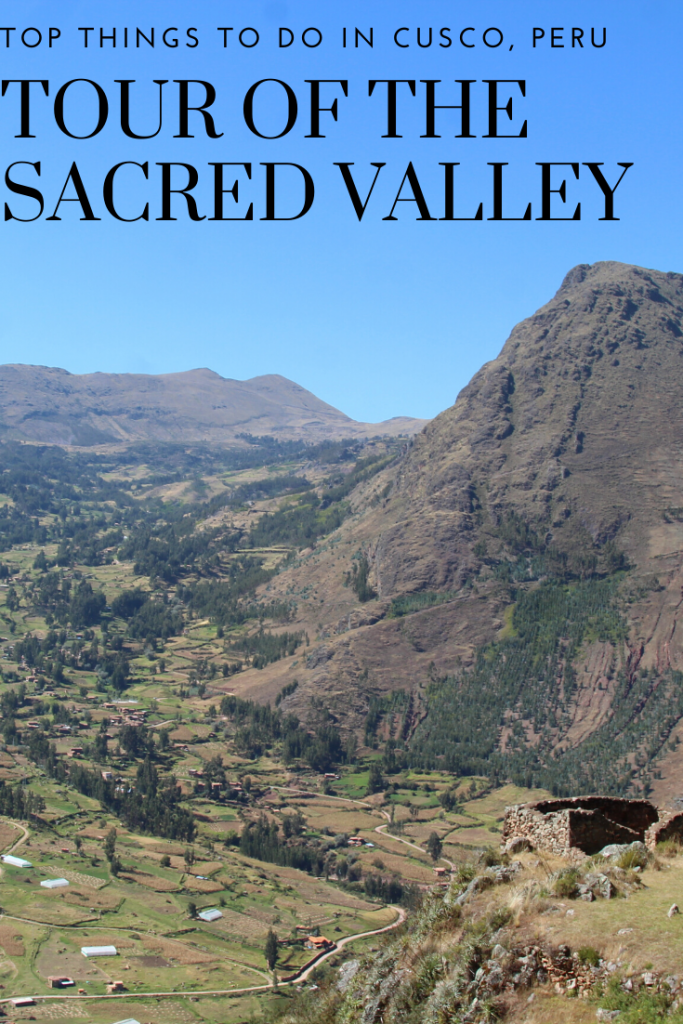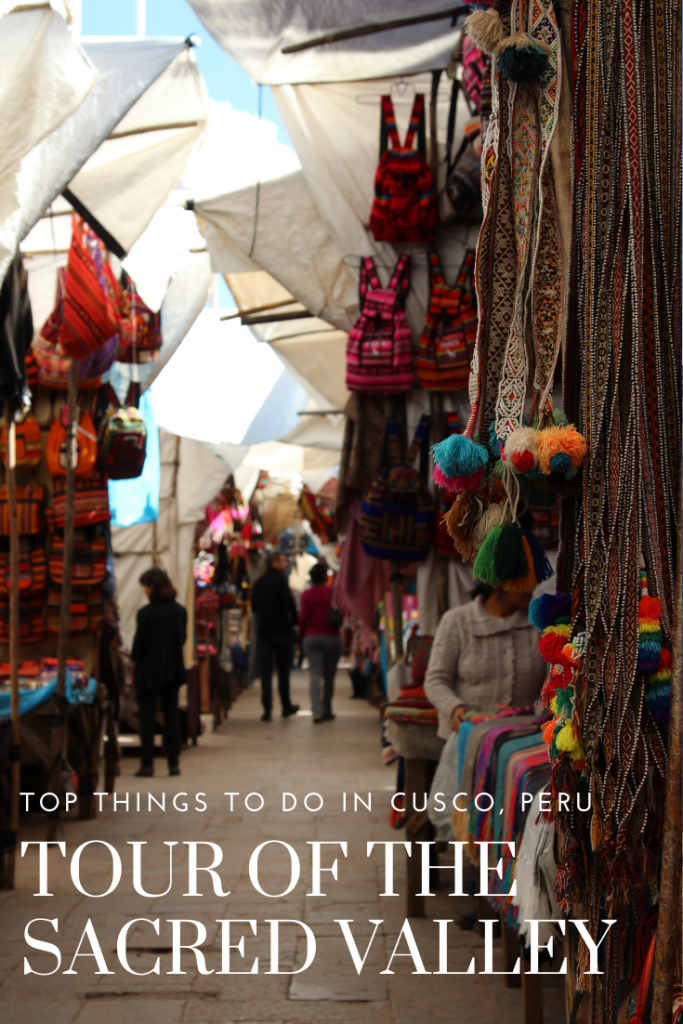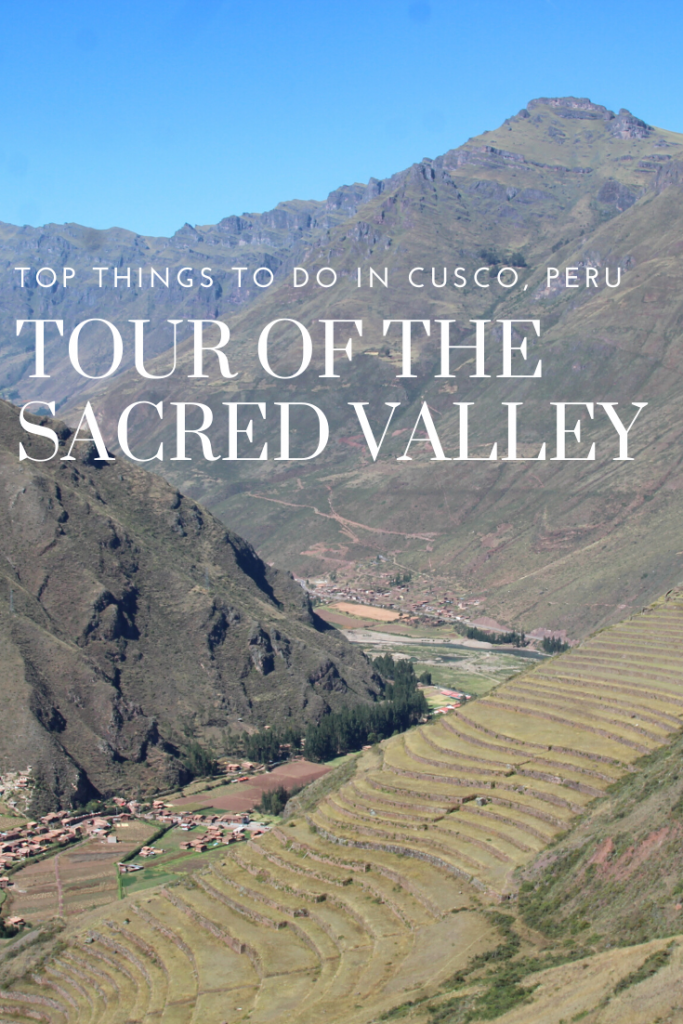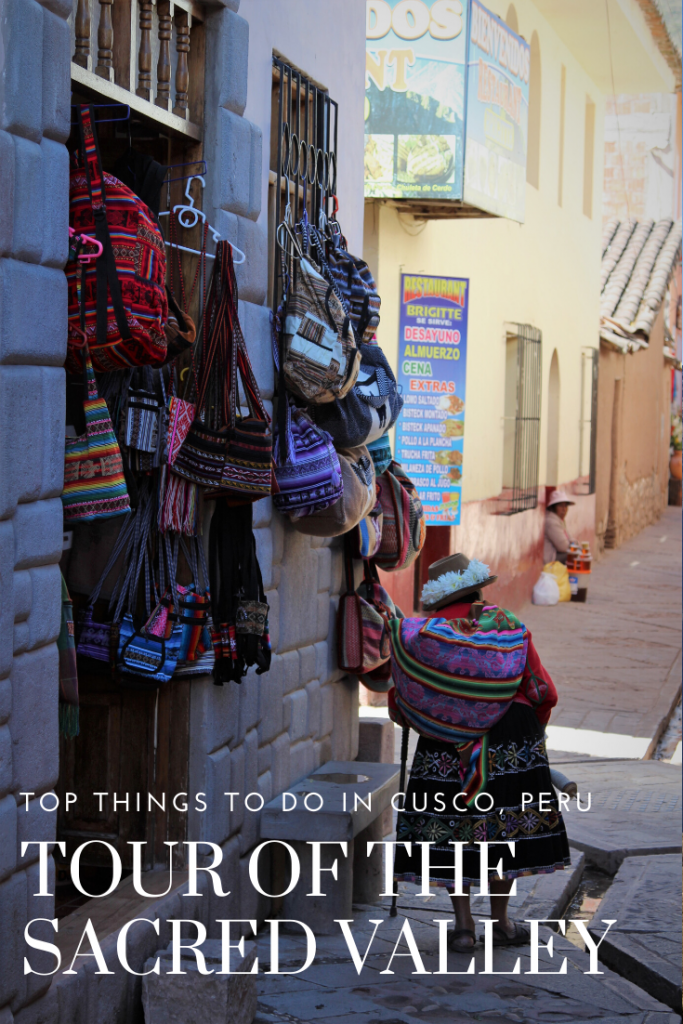The Sacred Valley
What is a trip to Peru without a visit to the famous Sacred Valley?
About as important a visit as seeing the top wonder of the World, Machu Picchu, the many sites and towns along the Urubamba (sacred) river are a must see. Preferrably over a few days with time to spend in each place. But if you are on a time crunch like we were, 1 day on a tour is what you get.
About our tour
On our 2nd day in Peru we opted to do a Sacred Valley Tour through Salkantay Trekking (the same company we were using for the trek) The plan was an early morning – start in Pisac and finish with Ollantaytambo – Chincerro district, effectively circling through the Sacred Valley and finishing on different sides of Cusco. The tour included our transportation, lunch, and guide but did not cover our entrance into the sites. There are 2 ticket combinations you can purchase- 1 which is comprehensive and covers the sacred valley AND the localized ruins around Cusco such as Sacsayhuaman and costs 130 soles. The other which just covers the 3 we were seeing plus Moray. As we didn’t think we’d have time to visit the many other sites, we opted for the cheaper ticket at 70 soles.
We bought yogurts and bars from the store the previous night so we gobbled those up at 6:30 before the guide picked us up just before 7. Our group only had 1 other couple in it making us a 6 person group which was nice for a more personalized trip.
We headed up the road learning about how Eucalyptus was planted around Cusco as it grows fast and provids fast wood for building- then stopped at our first stop just past the Sacsayhuaman ruins at an alpaca/ llama farm.
While the layout of this stop was largely commercial (also voluntary, they did give us the option of skipping the stop)- learn about how alpaca wool is harvested/ dyed/ and woven- then try to get us to buy some, I still appreciated the stop. We got to feed the alpacas and llamas which was fun and pet the ones who’d let us. The farm also had a couple Vicunya which are the smallest of the camelid family and by far the softest. It was great interacting with so many of the animals and I did find the types of materials they used for dye interesting. That being said… I also got guilted into buying a very expensive pair of socks – $30 (cheapest thing I could find) woven from baby alpaca wool that I figured would make a decent gift for Braden. (Hope you love them babe! )
My favorite guy: This is a great time to point out that Alpaca don’t have top front teeth… only bottom giant ones!
A cute little Vicuña, the smallest of the camelid family!
And a llama
Looking down the center of the farm. Llamas on the left, alpacas on the right.
Then onto our next stop!
A viewpoint of the Sacred Valley we stopped at on our way to Pisac.
After the farm, it was another hour or so onto the archeological site of Pisac. We didn’t have nearly as much time at the site as I would’ve liked, but we walked around learning from the guide and grabbing a few photos of the view down the valley.
The temple sitting at the top of all of the site.
About Pisac
The coolest part about Pisac is the astounding view and many terraces that laid out beneath the ruins. The view down the Sacred Valley is incredible and the terraces make awesome photo additions. This was our first taste of the ingenuity of the Incas as we learned not only were the terraces built for farming but also to prevent land slides and erosion beneath their temples. The site itself is divided into groups – the Temple of the Sun (where we walked around and at the very top), altars, baths, and water fountains. There were multiple rooms that the priests would live in (many people to a room) that had “built-ins” for holding golden idols. All pretty mind blowing to think about when standing in a stone room without a roof. The site was estimated to be built around 1440 and occupied until the Spanish destroyed it in the early 1530s. The town below wasn’t started until 1570. We learned a bit about the daily life at the site ending our tour with the “guinea pig” house room. A room with a smaller stone base built in with tiny little doors that the guide said the guinea pigs were kept and cared for in.
A small room that was used as a lodging for the priests in the temple
Views of the lower site
Next up we visited the town Pisac (below the ruins) where we had an hour to shop, visit the market, etc. Again there was a “demonstration” on how they make silver jewelry at a shop but the shop had fancy/ nice bathrooms so for the 3 minute demonstration, I found that a decent trade off. (Also didn’t get guilted into purchasing anything this time lol)
We wandered down the street to the colorful Pisac market which was really nice and apparently only runs on Sundays/Tues/Thurs so we got lucky there. While I’d already bought a few things at shops in Cusco, I enjoyed bartering a bit more with the street sellers in the market and winded up buying way more than I should’ve considering I had to haul it all home in a little carry-on! We met back up with our group and guide at the silver shop before travelling another hour or so to the town/ archaeological site of Ollantaytambo.
Views in the market
About Ollantaytambo
Again I would’ve loved to have more time to explore the site (without the guide) and take more photos particularly as this site itself was probably my favorite of the day. While the view isn’t as spectacular, the site is huge with multiple running fountains still, and had the most interesting history to its name. Tambo- which means resting place and “Olly” comes from a famous general named Ollantay who fortified himself in that temple while leading a rebellion to win the love of an Incan Princess. The site also has awesome history as it became the main fortified retreat for the Inca Manco who lead the rebellion against the Spanish in Cusco. It’s defensive position was one of the more successful against the Spanish as the Incas were able to flood the valley and defend the high walls above the terraces. That being said- it like many other ruins were abandoned for stronger jungle foot holds and was eventually… ruined by the Spanish.
It’s also shaped like a llama which we’ve determined, I’m quite obsessed with.
The town at the base of the ruins (Would definitely stay here to explore the Sacred Valley more if we’d had more time)
Across from the temple/ fort were more ruins used as granaries and food storage
The balcony path we took to head down a different way
This site also had the best example of the incredible masonry of the Incas (that we visited). In the distance it was possible to see their main quarry (higher up on a mountain) from where they moved boulders weighing more than 50 tons about 20 km, sanded down and chiseled away, and created “lego” like locking pieces so that no mortar was needed. The stones fit together exactly creating an incredible strong and beautiful wall. There were a couple places where you could see the face of a jaguar caved into the rock or Chanakas (the Incan cross) which were incredibly neat with how they have withstood erosion. We learned more of how the Incans moved the boulders with wood and smaller rocks to roll them on before we took the balcony path down to the baths/ fountains. Again there was amazing masonry work as you could see the ornamental carving around the still flowing ceremonial fountains.
By the time we walked through the fountains we were pushing 2:30 and everyone was getting a little hungry, so another 20 minutes down the road we arrived at our lunch spot.
Lunch was glorious- honestly one of the best parts of the day tour. The restaurant was cleverly open air- with live musicians playing very mountainous Andes music, and buffet style options for every taste. We left feeling very full after sampling a little bit of everything.
Another view point we stopped at on our way back toward Cusco
After lunch we headed to our last stop and point of interest: Chinchero. Specifically the colonial church there “Iglesia Colonial de Chinchero” This town was at the summit of our adventures that day, sitting at 12,350 feet above sea level, (the highest altitude we visited in Peru thus far) and was once again built on Incan ruins. The large terraces are largely still used today for agriculture as the soil in Chinchero is the most fertile in all of the Sacred Valley. At the colonial church you can see the original Incan foundation from the temple that once stood there. The inside of the church is perhaps even more beautiful than some of the big cathedrals- every wall and ceiling space decorated/ painted with floral and religious symbols. Since we got there later in the day we missed most of the crowds but if you are looking for a more local themed market- their Sunday market is said to be much more “local” than the larger market at Pisac. The town is very quaint so I enjoyed the little “uphill “ walk we had between the parking lot/ government checkpoint for tickets and the church.
We also got to see some dancers/ festival going on by the church which was also awesome to see! (considering we missed the parade in Cusco again this day)
The church courtyard with Incan foundations
Walking around town
The town has QUITE the steep streets
After Chincero, we had a shorter 45 minute drive back into Cusco. We were dropped off back by our apartment where we changed into warmer clothes for the evening and set out to explore a bit more. For dinner this round we chose a place previously recommended from friends that was good, though maybe not as spectacular as other meals we had. It was amazing how cold it got in the evenings but luckily this round I prepared with my puffy before heading out. Since most things were closing up, we just walked around more parts of the city near the apartment enjoying the lights and evening vibes. Then it was back to our home away from home.
| Sacred Valley Day Costs | |
| Breakfast- groceries from previous day | |
| Tour – $50 *Included lunch but not drinks Drink at lunch $5 |
|
| Tour guide and driver tip $7.50 | |
| Entrance to archaeological sites $21 | |
| Dinner at Los Toldos Chicken $10.30 | |
| Airbnb $45 – $11.25 pp
|
Pin me:





